1998 PONTIAC GRAND PRIX wiper blades
[x] Cancel search: wiper bladesPage 111 of 402

Windshield Wipers
You control the windshield wipers by turning the band
marked WIPER. For a single wiping cycle, turn the band
to MIST. Hold it there until the wipers start, then let go.
The wipers will stop after one cycle. If you want more
cycles, hold the band on MIST longer.
For steady wiping at low speed, turn the band to LOW.
For high-speed wiping, turn the band further, to HIGH.
To stop the wipers, turn the band to OFF.
You can set the wiper speed for a long or short delay
between wipes.
This can be very useful in light rain or
snow.
Turn the band to choose the delay time. The
closer to
LOW, the shorter the delay.
Be sure to clear ice and snow from the wiper blades
before using them. If they’re frozen
to the windshield,
carefully loosen or thaw them. If
your blades do become
damaged, get new blades
or blade inserts.
Heavy snow or ice can overload your wipers.
A circuit
breaker will stop them until
the motor cools. Clear away
snow or ice
to prevent an overload.
2-36
Page 212 of 402
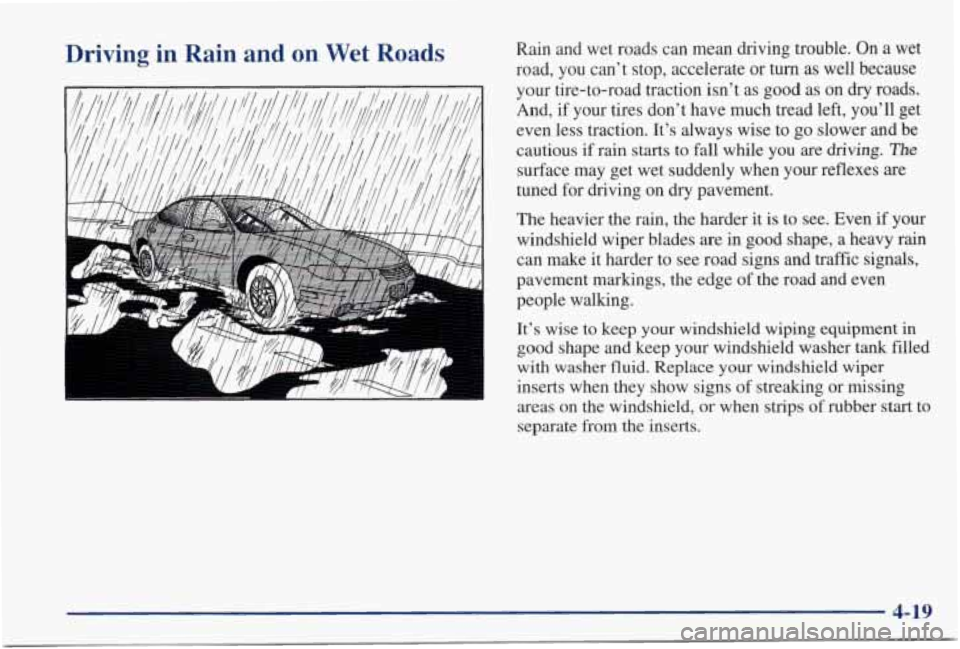
Driving in Rain and on Wet Roads Rain and wet roads can mean driving trouble. On a wet
road, you can't stop, accelerate
or turn as well because
your tire-to-road traction isn't as
good as on dry roads.
And, if your tires don't have much tread left,
you'll get
even less traction. It's always wise to
go slower and be
cautious if rain starts to fall while you are
driving. The
surface may get wet suddenly when your reflexes are
tuned for driving on
dry pavement.
The heavier the rain, the harder
it is to see. Even if your
windshield wiper blades are in good shape, a heavy rain
can make it harder to see road signs and traffic signals,
pavement markings, the edge of the road and even
people walking.
It's wise to keep your windshield wiping equipment
in
good shape and keep your windshield washer tank filled
with washer fluid. Replace your windshield wiper
inserts when they show signs of streaking or
missing
areas on the windshield, or when strips of rubber start to
separate from the inserts.
4-19
Page 217 of 402
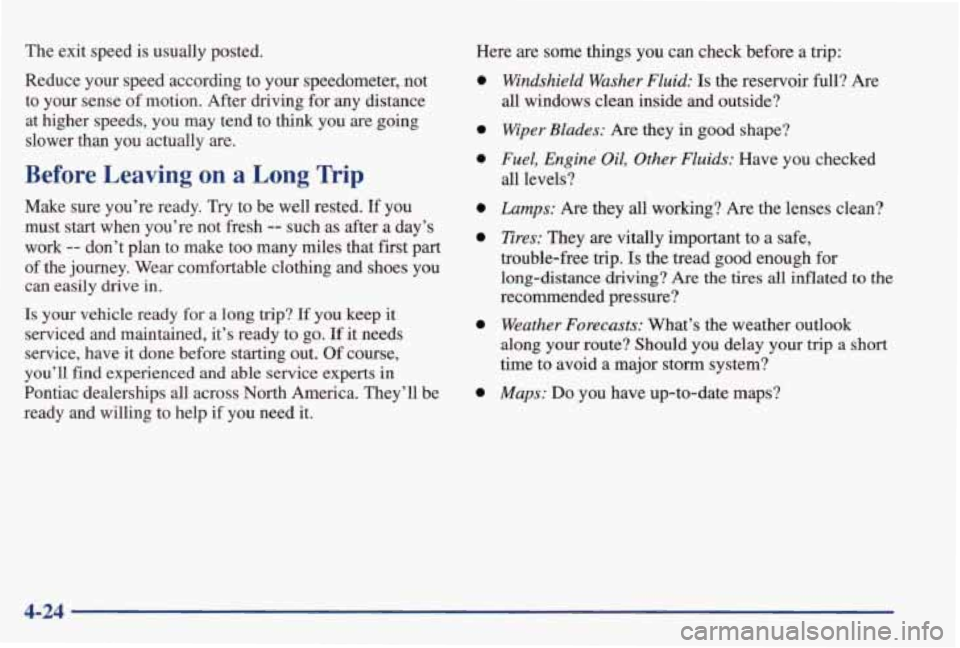
The exit speed is usually posted.
Reduce your speed according
to your speedometer, not
to your sense
of motion. After driving for any distance
at higher speeds, you may tend to think you are going
slower than you actually
are.
Before Leaving on a Long Trip
Make sure you’re ready. Try to be well rested. If you
must
start when you’re not fresh -- such as after a day’s
work
-- don’t plan to make too many miles that first part
of the journey. Wear comfortable clothing and shoes you
can easily
drive in.
Is your vehicle ready for a long trip? If you keep it
serviced
and maintained, it’s ready to go. If it needs
service, have it done before starting out.
Of course,
you’ll find experienced
and able service experts in
Pontiac dealerships all across North America. They’ll be
ready and willing to help if you need it. Here are some things you can check before a trip:
0
0
0
0
0
0
0
Windshield Washer Fluid: Is the reservoir
full? Are
all windows clean inside and outside?
Wiper Blades: Are they in good shape?
Fuel, Engine Oil, Other Fluids: Have you checked
all levels?
Lamps: Are they all working? Are the lenses clean?
Tires: They are vitally important to a safe,
trouble-free trip.
Is the tread good enough for
long-distance driving? Are the tires all inflated to the
recommended pressure?
Weather Forecasts: What’s the weather outlook
along
your route? Should you delay your trip a short
time to avoid
a major storm system?
Maps: Do you have up-to-date maps?
4-24
Page 330 of 402
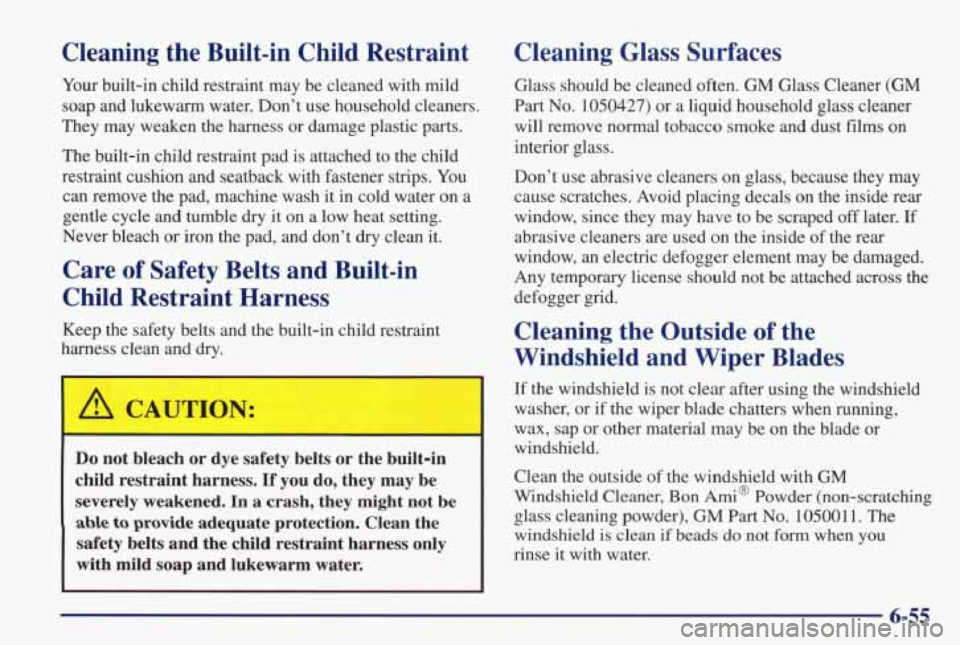
Cleaning the Built-in Child Restraint
Your built-in child restraint may be cleaned with mild
soap and lukewarm water. Don’t use household cleaners.
They may weaken the harness or damage plastic parts.
The built-in child restraint pad is attached to the child
restraint cushion and seatback with fastener strips. You
can remove the pad, machine wash it in cold water on a
gentle cycle and tumble
dry it on a low heat setting.
Never bleach or iron the pad, and don’t
dry clean it.
Care of Safety Belts and Built-in
Child Restraint Harness
Keep the safety belts and the built-in child restraint
harness clean and
dry.
I A CAUTION:
Do not bleach or dye safety belts or the built-in
child restraint harness. If you do, they may be
severely weakened. In a crash, they might not be
able to provide adequate protection. Clean the
safety belts
and the child restraint harness only
with mild soap and lukewarm water.
Cleaning Glass Surfaces
Glass should be cleaned often. GM Glass Cleaner (GM
Part No. 1050427) or a liquid household glass cleaner
will remove normal tobacco smoke and dust films on
interior glass.
Don’t use abrasive cleaners on glass, because they
may
cause scratches. Avoid placing decals on the inside rear
window, since they may have to be scraped
off later. If
abrasive cleaners are used on the inside of the rear
window, an electric defogger element may be damaged.
Any temporary license should not be attached across the
defogger grid.
Cleaning the Outside of the
Windshield and Wiper Blades
If the windshield is not clear after using the windshield
washer, or if the wiper blade chatters when running,
wax, sap or other material may be on the blade or
windshield.
Clean the outside of the windshield with GM
Windshield Cleaner, Bon
Ami@ Powder (non-scratching
glass cleaning powder), GM
Part No. 105001 1. The
windshield is clean if beads
do not form when you
rinse it with water.
Page 331 of 402
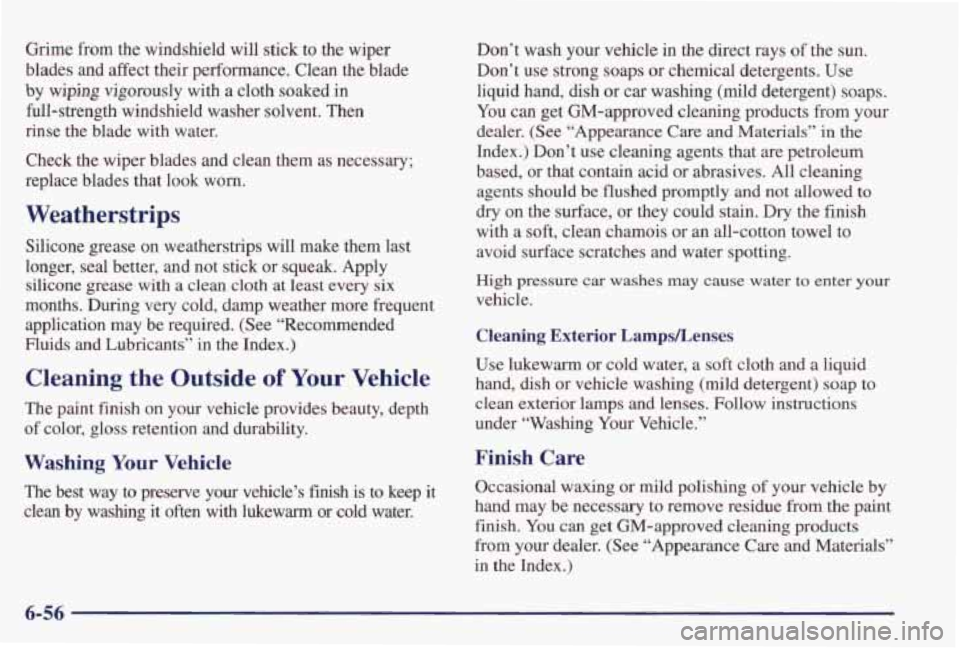
Grime from the windshield will stick to the wiper
blades and affect their performance. Clean the blade
by wiping vigorously
with a cloth soaked in
full-strength windshield washer solvent. Then
rinse the blade with water.
Check the wiper blades and clean them as necessary;
replace blades that look worn.
Weatherstrips
Silicone grease on weatherstrips will make them last
longer, seal better, and not stick or squeak. Apply
silicone grease
with a clean cloth at least every six
months. During very cold, damp weather more frequent
application may be required. (See “Recommended
Fluids and Lubricants” in the Index.)
Cleaning the Outside of Your Vehicle
The paint finish on your vehicle provides beauty, depth
of color, gloss retention and durability.
Washing Your Vehicle
The best way to preserve your vehicle’s finish is to keep it
clean by washing it often with lukewarm or cold
water.
Don’t wash your vehicle in the direct rays of the sun.
Don’t use strong soaps or chemical detergents. Use
liquid hand, dish or car washing (mild detergent)
soaps.
You can get GM-approved cleaning products from your
dealer. (See “Appearance Care and Materials” in the
Index.) Don’t use cleaning agents that are petroleum
based, or that contain acid or abrasives.
All cleaning
agents should be flushed promptly and
not allowed to
dry on the surface, or they could stain. Dry the finish
with a
soft, clean chamois or an all-cotton towel to
avoid surface scratches and water spotting.
High pressure car washes may cause water to enter your
vehicle.
Cleaning Exterior LampsLenses
Use lukewarm or cold water, a soft cloth and a liquid
hand, dish or vehicle washing
(mild detergent) soap to
clean exterior lamps and lenses. Follow instructions
under “Washing Your Vehicle.”
Finish Care
Occasional waxing or mild polishing of your vehicle by
hand may be necessary to remove residue from the paint
finish.
You can get GM-approved cleaning products
from your dealer. (See “Appearance Care and Materials”
in the Index.)
6-56
Page 345 of 402

Normal Maintenance
Replacement Parts
......... A1208C
Air Cleaner Filter
Battery
All Engines ..............
3100 (Code M) ......... ........ 600CCA
3800
(Code K) ...................... 690 CCA
3800 Supercharged (Code 1) ........... 770 CCA
All Engines ................. AC PF47
All Engines ...................... CV892C
Engine Oil Filter
PCV
Valve
Radiator Cap
All Engines ... .............. AC RC27
Spark Plugs
3100 (Code M) . . ......... AC Vpe 41-940
Gap: 0.060 inches (1.52 cm)
3800 (Code K) ................ AC Type 41-921
Gap: 0.060 inches (1.52 cm)
3800 Supercharged (Code 1) . . AC Qpe 41-921 or
NGK 5pe PTR4B- 15
Gap: 0.060 inches (1.52 cm)
Wiper Blades
vpe ................................. Hook
Length ................... .20 inches (50.8 cm) -
Air Conditioning Refrigerants
Not all air conditioning refrigerants are the same. If
the air conditioning system in your vehicle needs
refrigerant, be
sure the proper refrigerant is used. If
you’re not sure, ask your dealer.
6-70
Page 360 of 402
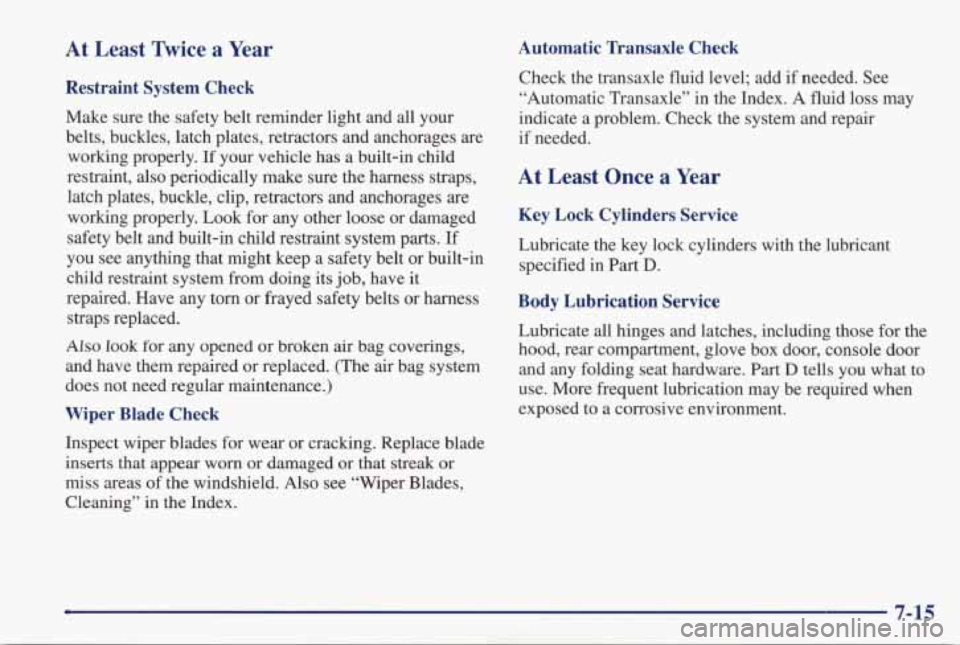
At Least Twice a Year
Restraint System Check
Make sure the safety belt reminder light and all your
belts, buckles, latch plates, retractors and anchorages are working properly. If your vehicle has
a built-in child
restraint, also periodically make sure the harness straps, latch plates, buckle, clip, retractors and anchorages
are
working properly. Look for any other loose or damaged
safety belt and built-in child restraint system parts. If
you see anything that might keep a safety belt or built-in
child restraint system from doing its job, have it
repaired. Have any torn or frayed safety belts or harness
straps replaced.
Also look for any opened or broken air bag coverings,
and have them repaired or replaced. (The air bag system
does not need regular maintenance.)
Wiper Blade Check
Inspect wiper blades for wear or cracking. Replace blade
inserts that appear
worn or damaged or that streak or
miss areas of the windshield. Also see “Wiper Blades,
Cleaning” in the Index.
Automatic Transaxle Check
Check the transaxle fluid level; add if needed. See
“Automatic Transaxle” in the Index. A fluid loss may
indicate a problem. Check the system and repair if needed.
At Least Once a Year
Key Lock Cylinders Service
Lubricate the key lock cylinders with the lubricant
specified in
Part D.
Body Lubrication Service
Lubricate all hinges and latches, including those for the
hood, rear compartment, glove box door, console door
and any folding seat hardware.
Part D tells you what to
use. More frequent lubrication may be required when
exposed to a corrosive environment.
7-15
Page 384 of 402

Glass .............. .................... 6-55
Inside of
Your Vehicle ......................... 6-53
Instrument Panel
............................. 6-54
Interior Plastic Components
..................... 6-54
Leather
..................................... 6-54
Outside of
Your Vehicle ........................ 6-56
Special Problems
............................. 6-53
Tires
............ ....... ........ 6-58
Wheels
........................... ...... 6-57
Windshield and Wiper Blades
................... 6-55
Climate Control System
........................... 3-2
Clock, Setting the
............................... 3-10
Column Shift
.................................. 2-28
Comfort Controls
.... ..................... 3-1
Compact Disc Care
....... .................. 3-32
Compact Disc Player
....................... 3-19, 3-22
Compact Disc Player Care
........................ 3-32
Compact Disc Player Errors
............. 3-21,3-23, 3-25
Compact Spare Tire ............................. 5-37
ConsoleShift
.................................. 2-29
Content Theft-Deterrent
.................... 2- 14, 2-50
Content Theft-Deterrent, Arming and Disarming
...... 2-51
Control of a Vehicle
.............................. 4-6
Convenience Net
............................... 2-57
Convex Outside Mirror
.......................... 2-53
Coolant
....................................... 6-26
BleedValves
................................. 5-24
Heater, Engine
............................. 2-20
Stains
...................................... 6-53
Vinyl
.......................... ........ 6-54 Recovery Tank
........ .... 5-20
To Use the Engine Heater .................... 2-20
Cooling System
................................ 5-18
Courtesy Lamps
................................ 2-42
Courtesy Transportation
........................... 8-8
Cruise Control
................................. 2-37
Customer Assistance for Text Telephone Users
......... 8-5
Customer Assistance Information ................... 8-1
Customer Satisfaction Procedure
.................... 8-3
Damage. Finish
... ...... 6-58
Damage. Sheet Metal
. . ...... ...... 6-58
Daytime Running Lamps
.............. ...... 2-41
Dead Battery
..................... .......... 5-3
Defects. Reporting Safety
........................ 8-10
Defensive Driving
............................... 4-2
Defogger. Rear Window .......................... 3-9
Defogging and Defrosting ..................... 3-4. 3-8
Defrosting. Defogging
.... ........ 3-4. 3.8
Delayed Illumination ............ .... 2.43. 2.47
Dimensions. Vehicle
............... ...... 6-69
Disarming with the Remote Keyless Entry Transmitter
................. .... 2-15
Disarming with
Your Key ...................... 2-15
Dolby@ B Noise Reduction
.................. 3.14. 3.18
DoorLocks
..................................... 2. 4
Driver Information Center ........................ 2-76
Driver Position
................................. 1-14
Driver’s Temperature Knob. Automatic
and
Auxiliary Temp Control ......................... 3-5
9-3